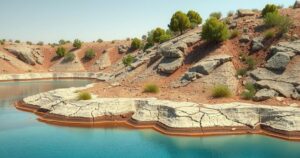Scientific Insights on Assisted Natural Regeneration in Argentina’s Desert Ecosystems

Research on assisted natural regeneration (ANR) in Argentina’s Monte Desert reveals that, while restoration techniques show lower plant density and diversity compared to undisturbed sites, they allow for the presence of 40% of expected species. Ongoing investigations emphasize the need to focus on soil microbiomes and explore active restoration interventions to enhance ecological recovery in arid desert environments.
In Neuquén province, Argentina, local regulations mandate that oil companies create furrows to facilitate plant growth as part of assisted natural regeneration (ANR) to restore decommissioned drilling sites. A recent study analyzed 16 such sites compared to undisturbed deserts over five years, revealing that restored areas exhibited lower plant density, diversity, and coverage. Nonetheless, researchers noted an unexpected variety of species flourishing in these sites, indicating potential for ecological recovery.
The hostile environment of Argentina’s Monte Desert presents several challenges for plant life, including extreme temperature fluctuations, scarce rainfall, and nutrient-deficient soil. Historic oil drilling and the recent surge in fracking have devastated many areas, resulting in the destruction of vegetation and replacement of soil with heavily compacted dirt. Consequently, native plants struggle to re-establish themselves in their original habitats after drilling operations cease.
A study conducted by researchers from the National University of Comahue assessed the effectiveness of ANR techniques. Findings indicated that while the restored sites show lower plant density and diversity than undisturbed areas, approximately 40% of the native species were present within the ANR sites. Certain unexpected species, previously categorized as climax species, also emerged in the restored environment, which was a pleasant surprise to the research team.
According to Florencia del Mar González, the primary investigator, their initial satellite observations suggested little regeneration at these drilling sites. However, upon conducting field research, the team noticed a response from the ecosystem, indicating potential for growth in specific locations. ANR involves passive practices that enhance conditions to promote natural plant growth rather than employing more intensive measures like reseeding or replanting, thus making it a cost-effective intervention.
Del Mar González’s investigation involved sampling and assessing both ANR-remediated sites and nearby ecological reference (ER) sites. While the study found a decrease in overall plant coverage—12.5 times lower in degraded sites compared to ER locations—the presence of diverse species suggested some benefits of ANR. The findings also highlighted the critical role of “nurse” plants that improve soil conditions and provide necessary shielding for seedlings.
James Aronson from the Missouri Botanical Garden emphasized the significance of understanding soil microbiomes for successful restoration. He noted that desert conditions lead to slow plant growth, and recovery may take decades, making any observed progress valuable. Current and future collaborations aim to explore soil health, a vital aspect of restoring the desert’s ecosystems.
Del Mar González’s research points out that deeper furrows than the mandated 15 centimeters could yield better results for water retention and cooler soil temperatures. The work conducted in the Monte Desert could also apply to various human-altered environments globally, suggesting that strategies for environmental recovery are essential whenever infrastructure impacts natural habitats.
The study on assisted natural regeneration (ANR) in Argentina’s Monte Desert shows that while restoration techniques currently mandated by local law yield limited results, they still promote species diversity in degraded environments. Continued research into soil microbiomes will enhance understanding of ecosystem recovery, and active restoration methods—such as employing deeper furrows and introducing nurse plants—may significantly benefit plant regrowth in arid conditions. This research underlines the importance of developing comprehensive strategies for ecological restoration in human-impacted ecosystems.
Original Source: news.mongabay.com






